|
|
|
Sort Order |
|
|
|
Items / Page
|
|
|
|
|
|
|
| Srl | Item |
| 1 |
ID:
093763


|
|
|
|
|
| Publication |
2010.
|
| Summary/Abstract |
The 'Holiday of Holidays' is a unique event of coexistence in the Israeli landscape as well as in the entire Middle East. The festival unites the three religions: the Christian Christmas, the Jewish Hanukkah and the Muslim Ramadan. It has been taking place for the past 15 years in November-December in the Wadi Nisnas neighbourhood of Haifa, Israel. This is a colourful celebration of art, music, fragrances, tastes and magnificent holiday lighting that creates syncretism between old and new, languages and religious symbols. The organizers choose universal elements: food, commerce and art, which are disengaged from conflictual contexts. Beyond the commercial-tourist aspect, this festival creates 'another place' with encounters between hostile groups.
|
|
|
|
|
|
|
|
|
|
|
|
|
|
|
|
| 2 |
ID:
143644
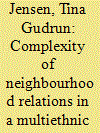

|
|
|
|
|
| Summary/Abstract |
This article examines the nature of coexistence in a multiethnic social housing project in Copenhagen, focusing on neighbourhood relations between majority Danes and ethnic minorities. Despite the general assumption that ethnic majorities and minorities have no neighbourhood relations, this case study reveals multifarious ways of relationship-making. Whereas the residents tended to emphasise separation between ethnic groups, their everyday practices indicated coexistence. These contrasts reflect the residents’ affirmations and contestations of the public national discourse about immigration, social integration and urban life. The variety of neighbourhood practices illustrates a complex social reality characterised by contrasts and ambivalences that represent different orders of identification and interaction and constitute coexisting tendencies of boundary maintenance and conviviality.
|
|
|
|
|
|
|
|
|
|
|
|
|
|
|
|
| 3 |
ID:
178046
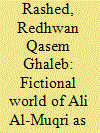

|
|
|
|
|
| Summary/Abstract |
This study aims at highlighting the artistic and intellectual vision of Ali Al-Muqri, a prominent contemporary Yemeni novelist, in The Handsome Jew, a narrative that marks a sharp departure from the works of his contemporaries in terms of its themes, technical devices, and discursive strategies. Much has been written about the relation between Muslims and Jews in the world literature. However, most, if not all, have a masculine stamp. The norm has been reversed here, Fatima, an educated Muslim woman, loves Salem, the Jew, and marries him. In contrast to the derogatory image of the Jew in literature, Salem seems open-minded and very humane. It is hypothesized that all religions are subject to interpretation according to human needs and that all religions are a source of union, not separation. Building on an eclectic theoretical framework with the analytical method, this study analyzes The Handsome Jew that is still incarcerated within the local Yemeni linguistic and cultural barrier and aims to locate the Yemeni narrative in the realm of Arabic and world literature. The conclusions of the study are as follows: despite different religions and cultures, there is a possibility for coexistence and establishing social relationships, as it happened with Fatima and Salem, who introduce a kind of sublime human reconciliation that has not touched the sacred belief of both. Learning the other’s culture and reading freely, away from the preceding and inherited views, is essential for a healthy society. It would make Muslims love the Jews and would make the Jews love the Muslims. Love is a natural humanistic energy that challenges human-made cultural barriers.
|
|
|
|
|
|
|
|
|
|
|
|
|
|
|
|
| 4 |
ID:
117883
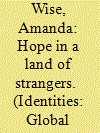

|
|
|
|
|
| Publication |
2013.
|
| Summary/Abstract |
This response to Ash Amin's new book, 'Land of Strangers' considers his argument that an 'urban commons' of multiplicity must be underpinned by a cultural imaginary that creates momentum and musters sentiment with affective force. He argues encounters are always deeply mediated and attitudes shaped by material, technological and symbolic influences with provenances near and remote. This paper targets the sphere of public narratives of encounter, providing two examples of interventions aimed at mobilising sentiment towards ideas of intercultural solidarity and care, and at re-working place identities in ways that highlight multiplicity, interdependency, and intersecting realities.
|
|
|
|
|
|
|
|
|
|
|
|
|
|
|
|
| 5 |
ID:
123494
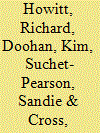

|
|
|
|
|
| Publication |
2013.
|
| Summary/Abstract |
Focusing on the coexistence of competing and contested interests in intercultural natural resource management (NRM) systems in Australia and Malaysia, this paper explores the ways in which ontological pluralism and the interplay of socio-cultural, political-economic and biophysical influences shape NRM systems. We aim to foster a discursive space in which to reframe the challenges of capacity building in the rapidly changing spaces of intercultural NRM systems. The paper synthesizes the conceptual arguments of field research to conclude that capacity deficits of dominant institutions, processes and knowledge systems drive many systemic failures in land and sea management affecting Indigenous peoples. We advocate urgent action to build intercultural competence and new capacities and competencies in those institutions. The paper reframes intercultural NRM in terms of coexistence and invites wider debate about these 'new geographies of coexistence' in intercultural NRM systems.
|
|
|
|
|
|
|
|
|
|
|
|
|
|
|
|
| 6 |
ID:
179990


|
|
|
|
|
| Summary/Abstract |
In this introduction, we situate the special section, ‘Containing Religious Offence beyond the Courts’, within and beyond existing scholarship on religious offence in South Asia. Much of this scholarship focuses on the unintended effects of blasphemy laws, showing, for instance, that laws presumably intended to promote religious tolerance end up informing, if not encouraging, disputes around religious sensitivities. But while debates about the effects of law are crucial, we suggest that a more nuanced understanding of religious offence can be gained if we look past full-blown legal proceedings and the spectacular violence performed in the streets during religious offence controversies. This collection, then, directs attention to the friction around religious sensitivities that are handled and often mitigated locally—either entirely outside the courts or through bottom-up initiatives that unfold in combination with, or as a reaction to, top-down measures. Drawing on the extensive empirical field research of six scholars of religion and politics, these essays document existing containment modalities in diverse geographical and socio-religious settings in India and critically scrutinise their functioning and outcomes. They explicitly engage with critical understandings of peace and with scholarship on the micro-mechanism of coexistence and, in so doing, open up new avenues of enquiry about religious offence.
|
|
|
|
|
|
|
|
|
|
|
|
|
|
|
|
| 7 |
ID:
146771
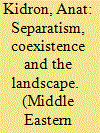

|
|
|
|
|
| Summary/Abstract |
Haifa was named a ‘mixed city’ by the British, who ruled Palestine from 1917 to 1948, in reference to the two national communities that inhabited the town. This definition was not neutral, and reflected the Brits aspirations to create national coexistence in Palestine among the diverse urban societies.
|
|
|
|
|
|
|
|
|
|
|
|
|
|
|
|
|
|
|
|
|